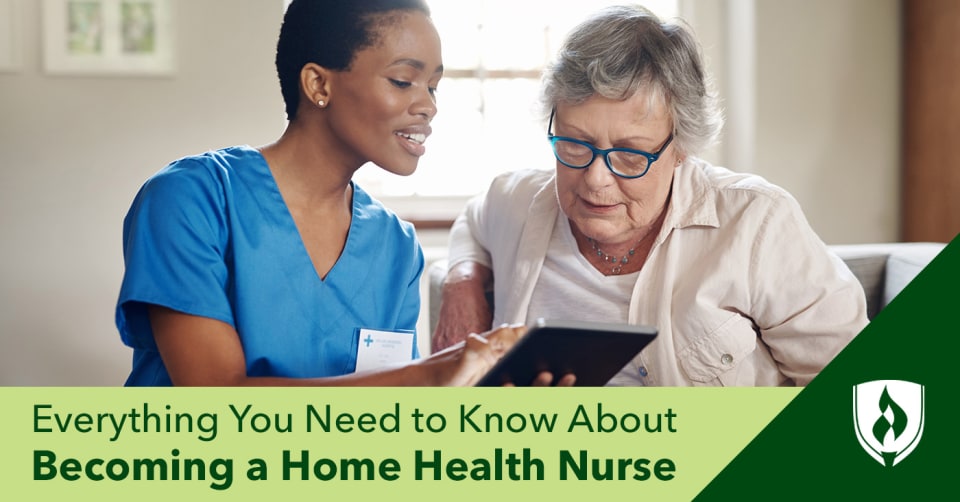
The thought of working in the medical field has always intrigued you. You know that healthcare is a growing, stable area of expertise, and you love the idea of interacting with patients and changing their lives for the better on a daily basis. All the signs seem to be pointing you toward nursing as your new career, but spending all day in a hectic hospital or under the fluorescent lights of a clinic might not be appealing to you.
Luckily, there are plenty of options for healthcare workers who don’t enjoy traditional medical environments. Nurses have the flexibility to use their talents in a work environment that not only benefits patients but also works well with their own personality, lifestyle and schedule commitments.
One nursing option to consider is home health nursing. Find out if this rewarding healthcare career is the right option for you as we break down everything you need to know about becoming a home health nurse. Or read more about Vascular Access Nursing.
What does a home health nurse do?
Home health nurses visit patients in their own homes to deliver medical care when a patient (or their family) is unable to care for themselves. You may think of home health nurses as mainly helping elderly adults struggling with dementia or ailments that limit their mobility, but the illnesses home health nurses treat go beyond that.
These nurses care for everyone from older adults to people with mental illnesses to those recovering from surgery. “You can expect to see wounds of all kinds. Some other common ailments home health nurses treat include diabetes, congestive heart failure and infections,” says Larissa Pourron, RN and nursing supervisor at TheKey®.
Just like nurses working in a hospital setting, home health nurses can expect to tackle a wide variety of job duties, including responsibilities like taking vital signs, helping patients with mobility issues, cleaning wounds, administering medication and drawing blood. Pourron adds that teaching also comes into play as a home health nurse, such as educating a patient recently diagnosed with diabetes or instructing a patient and their family about the signs of heart failure.
Home health nurses also need to report back to their employers and keep their patients’ medical records up to date, so maintaining accurate paperwork is as much a part of the job for home health nurses as it is for RNs staffing a hospital or clinic.
What is the work environment of a home health nurse?
These nurses typically work for a home health agency that will match them with patients to care for. They can expect to travel to their patients’ homes and work either on shifts, assisting one patient for several hours at a time, or intermittently, traveling to care for several patients in one day. Depending on the employer, many home health nurses are able to choose between more traditional work hours and a flexible schedule, such as working overnights, working four days per week or working some weekends.
What’s it like being a home health nurse?
“Being able to see the patient in their own home is one of the best and worst aspects of home health,” Pourron says. “It’s much different than working in a more familiar, predictable setting like a hospital or other medical facility.”
Though home health nurses still care for multiple patients, they only visit one at a time, giving them the opportunity to get to know their patients and their families on a more personal level. This can foster connections between nurses and patients that may not have developed in a busy hospital, making home health a rewarding career choice.
Being a home health nurse helped Pourron cultivate new perspectives on patient behavior. “I realized that sometimes patients didn’t take their medication simply because they were unable to afford it.” This new insight into “noncompliant” patients has made Pourron more compassionate and understanding as she seeks creative ways to help them meet their health goals.
Of course, there are downsides to working with patients in their homes. “You are often meeting patients and families who don’t want you there,” Pourron says. “They want to live their life independently, and as the nurse, you can be seen as an interruption or nuisance.” She notes that some home environments are more welcoming than others.
Despite those kinds of variables, Pourron knows home health nursing is the most fulfilling option for her. “I love being able to see our patients accomplish their goals and become healthier. It’s so fulfilling to see a wound heal, teach a client how to manage their own diabetes after working with our nurses and caregivers, or help a family learn how to give IV antibiotics to their loved one.”
What are some pros and cons of working as a home health nurse?
Every job has its ups and downs, and learning more about those specifics can help you understand the daily life of a home health nurse even better. Aside from the large variable of being in a patient’s own home, there are some other benefits and challenges to consider.
Con: Less team support
Home health nurses often perform their visits solo. Without the benefit of a care team or an entire unit working with you in a medical facility, home health nurses need to develop a wider array of skills to respond to problems that might arise. “With home nursing, you are mostly on your own,” says Beth Hawkes, MSN, RN-BC and owner of Nurse Code. She explains that you primarily need bedside care skills for the constant work, but you also need to develop the ability to respond well without aid in the case of an emergency.
Pro: More autonomy
The challenge of working alone is also a perk in certain ways. Hawkes says home health nurses have a great deal of professional autonomy. The skills you develop while needing to make choices on your own, field new variables and respond to different patient and family situations are extremely valuable skills for the nursing field at large. It’s an excellent role for people who like to work with more independence and have more agency in how they do their job.
Con: There’s a lot of documentation and paperwork
Home health nurses need to be highly meticulous with things like medication tracking, checking and double-checking dosages, timetables and pretty much every aspect of the treatment plan. Much of that needs documentation as well.
“We often spend hours intercepting mistakes,” Hawkes explains. “While you sleep happily obliviously, nurses are constantly checking and checking, protecting you from even the smallest mistake. When you wake up, we say, ‘Good morning!’ and leave it at that.”
Pro: It’s very individual-focused
Home health nurses have the added personal connection of being in a patient’s own residence. While this has its drawbacks, there’s no denying that it’s more intimate to work with someone in the place they call home. Hawkes says the best part is developing good relationships with patients and creating a care plan tailored to their specific needs and situations.
What qualities make for a successful home health nurse?
RNs need a unique set of characteristics to do well in this unique healthcare career. With no team of medical staff just down the hall, home health nurses need to be confident in their nursing abilities—and in their roles as patient advocates.
“Being a good advocate for your patients means calling the doctor when something isn’t going the way it should and monitoring your patients to ensure they’re safe,” Pourron says. Performing well independently and advocating or explaining patient needs to the physician are two skills that a great home health nurse needs.
Compassion and communication are also vital qualities. “Communicating with the family about their needs and arranging your visits around their schedule lets them know they are important,” Pourron says. She adds that educating patients and their families about disease and the recovery process is crucial in helping them reach their health goals, so home health nurses should be willing to devise creative teaching strategies!
How do you become a home health nurse?
The first step to becoming a home health nurse is to get educated. But with so many educational tracks for nurses, what makes the most sense for you? We used real-time job posting analysis software to review the listed education requirements of over 85,000 home health nursing jobs and found that 75 percent of these jobs require less than a bachelor’s degree.2 That means most home health nursing positions will be available to nurses who complete either a or Associate’s Degree in Nursing (ADN) program and pass the appropriate NCLEX® exam for their level of practice.
Once you’re licensed, you’re fully qualified to work as a home health nurse—though some employers may want to see prior experience working in general nursing settings.
Make a difference for patients every day
There’s no doubt that being a home health nurse is a fulfilling career outside of the traditional healthcare setting. As a home health nurse, you could go to work each day knowing you’ll make a difference in your patients’ lives.
If you’re interested in becoming a home health nurse, you need to get educated first. Fortunately, you have a few viable options—both LPNs and RNs can work in this role. If you’d like to learn more about the educational tiers of nursing and how they align with your career ambitions, check out our article “A Beginner’s Guide to Understanding the Levels of Nursing.”
Related Articles:
1Bureau of Labor Statistics, U.S. Department of Labor, Occupational Outlook Handbook, [accessed June 2022] www.bls.gov/ooh/. Data represents national, averaged earnings for the occupations listed and includes workers at all levels of education and experience. Employment conditions in your area may vary.
2Burning-Glass.com (analysis of education requirements for 86,573 home health nursing job postings, Jun. 15, 2021 - Jun. 14, 2022).
TheKey is a registered trademark of Homecare Assistance, LLC.
NCLEX is a registered trademark of the National Council of State Boards of Nursing, Inc.




